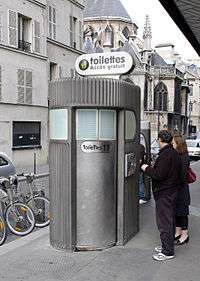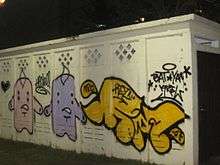Public toilet
A public toilet is a room or small building with toilets (or urinals) and sinks that does not belong to a particular household. Rather, the toilet is available for use by the general public, customers, travellers, employees of a business, school pupils, prisoners etc. Public toilets are commonly separated into male and female facilities, although some are unisex, especially for small or single-occupancy public toilets. Increasingly, public toilets are accessible to people with disabilities. Public toilets are known by many other names depending on the country. Examples are: restroom, bathroom, men's room, women's room in the US, washroom in Canada, and toilets, lavatories, water closet (W.C.), ladies and gents in Europe. In some parts of the world, they are referred to as the loo.
Some public toilets are free of charge while others charge a fee. In the latter case they are also called pay toilets and sometimes have a charging turnstile.
Local authorities or commercial businesses may provide public toilet facilities. Some are unattended while others are staffed by an attendant. In many cultures, it is customary to tip the attendant, especially if they provide a specific service, such as might be the case at upscale nightclubs or restaurants.
Public toilets are typically found in many different places: inner-city locations, offices, factories, schools, universities and other places of work and study. Similarly, museums, cinemas, bars, restaurants, entertainment venues usually provide public toilets. Railway stations, filling stations, and long distance public transport vehicles such as trains, ferries, and planes usually provide toilets for general use. Portable toilets are often available at large outdoor events.
Alternative names
.jpg)
.jpg)
Public toilets are known by many names in different varieties of English.
In American English, "restroom" commonly denotes a facility featuring toilets and sinks designed for use by the public, but "restroom" and "bathroom" are often used interchangeably for any room with a toilet (both in public and in private homes). "Restroom" is considered by some to be slightly more formal or polite. "Bathroom" is quite common in schools. "Comfort station" sometimes refers to a visitor welcome center such as those in national parks. The term restroom derived from the fact that in the early 1900s through to the middle of the century up-scale restaurants, theatres and performing facilities would often have comfortable chairs or sofas located within or in a room directly adjacent to the actual toilet and sink facilities, something which can be seen in some movies of the time period. An example of this is the description of a "movie palace" which was opening in 1921 which was described as including " ... a rest-room for the fair sex and a lounging room for the sterner sex ... off these rooms are the toilets."[1]
In Canadian English, public facilities are frequently called and signed as "washrooms", although usage varies regionally. The word "toilet" generally denotes the fixture itself rather than the room. The word "washroom" is rarely used to mean "utility room" or "mud room" as it is in some parts of the United States. "Bathroom" is generally used to refer to the room in a person's home that includes a bathtub or shower while a room with only a toilet and sink in a person's residence is typically called a "washroom" because you would wash your hands in it upon returning home or before a meal or a "powder room" because women would fix their make-up on their faces in that room. These terms are the terms typically used on floor plans for residences or other buildings. Real estate advertisements for residences often refer to "three-piece washrooms" (include a bathtub or shower) and "two-piece washrooms" (only toilet and sink). In public athletic or aquatic facilities, showers are available in locker rooms.
In Britain, Australia, Hong Kong, Singapore, and New Zealand, the terms in use are "public toilet", "public lavatory" (abbreviated "lav"), "public convenience", and more informally, "public loo". As public toilets were traditionally signed as "gentlemen" or "ladies", the colloquial terms "the gents' room" and "the ladies' room", or simply "the gents" and "the ladies" are used to indicate the facilities themselves. The British Toilet Association, sponsor of the Loo of the Year Awards, refers to public toilets collectively as "away-from-home" toilets.[2]
In Philippine English, "comfort room", or "C.R.", is the most common term in use.[3]
Some European languages used words cognate with "toilet" (e.g. les toilettes in French), or the initialism "W.C.", an abbreviation for "water closet", an older term for the flush toilet. Public urinals (pissoir) are known in several Romance languages by the name of a Roman Emperor: vespasienne in French, vespasiani in Italian, and vespasiene in Romanian.[4]
Mosques, madrassas (schools), and other places Muslims gather, have public sex-separated "ablution rooms" since Islam requires specific procedures for cleansing parts of the body before prayer. These rooms normally adjoin the toilets, which are also subject to Muslim hygienical jurisprudence and Islamic toilet etiquette.
Types



Many public toilets are permanent small buildings visible to passers-by on the street. Others are underground, including older facilities in Britain and Canada. Contemporary street toilets include automatic, self-cleaning toilets in self-contained pods; an example is the Sanisette, which first became popular in France.[5] An Indian version of these automated toilet pods, remotely monitored by sensors, are the Electronic Public Toilets or eToilets; they have proliferated across the country since 2014, as part of Swachh Bharat Abhiyan, the campaign launched that year to end open defecation.[6]
Public toilets may be "sitting toilets" WCs, as in most Western countries, or squat toilets. Squat toilets are common in many Asian and African countries, and, to a lesser extent, in Southern European countries.
Squat toilets are used all over the world, but are particularly common in many Asian and African countries, as well as Southern European Countries. In many of those countries, anal cleansing with water is also the cultural norm and easier to perform than with toilets used in a sitting position.
Another traditional type that has been modernized is the screened French street urinal known as a pissoir (vespasienne). An updated cylindrical urinal that lowers beneath street level out of the way and pops up during hours when it is needed is the Urilift Pop Up Urinal.[7] It is typically installed in entertainment districts and is operational only during weekends, evenings and nights. This urinal brand, invented in the Netherlands, also offers a pop-up toilet for women.[7]
Private firms may maintain permanent public toilets. The companies are then permitted to use the external surfaces of the enclosures for advertising. The installations are part of a street furniture contract between the out-of-home advertising company and the city government, and allow these public conveniences to be installed and maintained without requiring funds from the municipal budget.
Various portable toilet technologies are used as public toilets. Portables can be moved into place where and when needed and are popular at outdoor festivals and events. A portable toilet can either be connected to the local sewage system or store the waste in a holding tank until it is emptied by a vacuum truck. Portable composting toilets require removal of the container to a composting facility.
The standard wheelchair-accessible public toilet features wider doors, ample space for turning, lowered sinks, and grab bars for safety. Features above and beyond this standard are advocated by the Changing Places campaign.[8] Features include a hoist for an adult, a full-sized changing bench, and space for up to two caregivers.
Public toilets have frequently been completely inaccessible to certain people with disabilities.[9][10]
Purposes
As an "away-from-home" toilet room, a public toilet can provide far more than access to the toilet for urination and defecation. People also wash their hands, use the mirrors for grooming, get drinking water (e.g. refilling water bottles), attend to menstrual hygiene needs, and use the waste bins. Public toilets may also become places for harassment of others or illegal activities, particularly if principles of Crime prevention through environmental design (CPTED) are not applied in the design of the facility.
Health aspects
Health problems from lack of public toilets
Public toilets play a role in community health and individual well-being. Where toilets are available, people can enjoy outings and physical activities in their communities. By letting people get out of their cars and onto their feet, bicycles and mass transit, public toilets can contribute to improved environmental health. Mental well-being is enhanced when people are out with families and friends and know a place "to go" is available.
Public toilets also serve people who are "toilet challenged". First, some people need to go very frequently, including young and old people, females who are pregnant or menstruating, and those with some medical conditions. Second, some people need toilet access urgently, suddenly and without warning: such as those with chronic conditions such as Crohn's disease and colitis, and those temporarily afflicted with food-borne illnesses.
The inability to satisfy essential physiological needs because no toilet is available contributes to health issues such as urinary tract infections, kidney infections, and digestive problems which can later develop into severe health problems.[11] Inadequate access to a public toilets when required can lead to substantial problems for men with prostate problems, women who are menstruating or going through the menopause and anyone with urinary and fecal incontinence.
If bus and truck drivers on timed schedules have difficulty in accessing toilets, this puts them at risk of bladder and digestive health problems. Furthermore, if the concentration of a driver in urgent need is compromised, it becomes a broader public safety concern.
Workers therefore have legal rights to access a toilet during their work day. In the United States, the Department of Labor's Occupational Health and Safety protects workers' rights to toilet breaks because of the documented health risks.[12] This protected right to a toilet is a function of the workplace and is lost when workers leave the workplace.[13]
According to the Government of Australia, more than 3.8 million Australians of all ages are estimated to suffer continence issues.[14] This represents 18% of the Australian population. Therefore, the Department of Health and Ageing maintains the National Public Toilet Map to enable the public to find the closest facility.
Health risks from spreading disease
Public toilets may cause people to be infected with some diseases, particularly if hygiene is lacking. In 2020 during the COVID-19 pandemic, it become clear that COVID-19 spreads not only through respiratory droplets but through aerosol particles which remain suspended for much longer.[15] There are multiple touch points in public toilets – stall door locks, flush handles, and faucets.[15] The NGO PHLUSH has published guidelines on the safe reopening of public toilets.[15] This includes for example: "Place hand-hygiene stations at the entrance restrooms and ask users to clean hands before entering to avoid surface contamination." The guide also recommends to remove forced air hand dryers that can spread viruses and bacteria into the room.[16]
Design
Entry
Doorless entry
Modern public toilets may be designed with a labyrinth entrance (doorless entry), which prevents the spread of disease that might otherwise occur when coming in contact with a door. Doorless entry provides visual privacy while simultaneously offering a measure of security by allowing the passage of sound. Doorless entry also helps deter vandalism; fewer audible clues to another person entering discourages some vandals. Doorless entry may also be achieved simply by keeping an existing door propped open, closed only when necessary.
Coin operated entry
Pay toilets usually have some form of coin operated turnstile, or they have an attendant who collects the fee.
Privacy
People often expect a high level of privacy when using public toilets. Privacy expectations may include toilet cubicles, cubicle doors, urinal partitions and similar.
The World Health Organization states that toilets should be "suitable, private and safe to use for all intended users, taking into consideration their gender, age and physical mobility (e.g. disabled, sick etc.)" and "All shared or public toilets should have [...] doors that can be locked from the inside, and lights".[17]
Service access
Modern public toilets often have a service entrance, utilities passage, and the like, that run behind all the fixtures. Sensors are installed in a separate room, behind the fixtures. Usually the separate room is just a narrow corridor or passageway.
Sensors
Sensor-operated fixtures (faucets, soap dispensers, hand dryers, paper towel dispensers) prevent the spread of disease by allowing patrons to circumvent the need to touch common surfaces. Sensor-operated toilets also help conserve water by limiting the amount used per flush, and require less routine maintenance. Each sensor views through a small window into each fixture. Sometimes the metal plates that house the sensor windows are bolted on from behind, to prevent tampering. Additionally, all of the electrical equipment is safely behind the walls, so that there is no danger of electric shock. However, a RCCB must be used for all such electrical equipment.
Some public toilets have an automatic sensor controlled flushing system that flushes the toilet when the user steps away from the sensor. They might also have an additional button that the user can push to provide a second flush.
Urinals
.jpg)
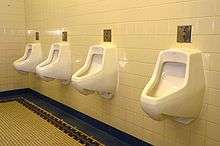
Urinals for males are common in public toilets as they are more space efficient than toilets (for urination). Urinals in public toilets are common in Western countries but less so in Muslim countries, partly due to Islamic toilet etiquette rules. Urinals for females exist but are rare. Urinals can be with automatic or manual flushing, or without flush water as is the case for waterless urinals. They can be arranged as single sanitary fixtures (with or without privacy walls) or in a trough design without privacy walls. The body posture for users of urinals is specifically the standing position. Compared with urination in a general-purpose toilet, usage is faster and more sanitary because at the urinal there are no fecal germs, no additional doors or locks to touch, and no seat to turn up. A urinal takes less space, is simpler, and consumes less water per flush (or even no water at all) than a flush toilet.
Lighting
Service lighting consisting of windows that run all the way around the outside of the toilet using electric lights behind the windows, to create the illusion of extensive natural light, even when the toilets are underground or otherwise do not have access to natural light. The windows are sometimes made of glass brick, permanently cemented in place. Lighting installed in service tunnels that run around the outside of the toilets provides optimum safety from electrical shock (keeping the lights outside the toilet), hygiene (no cracks or openings), security (no way for vandals to access the light bulbs), and aesthetics (clean architectural lines that maintain a continuity of whatever aesthetic design is present, e.g., the raw industrial urban aesthetic that works well with glass brick).
Cisterns (tanks)
Older toilets infrequently have service ducts and often in old toilets that have been modernized, the toilet cistern is hidden in a tiled over purpose-built 'box'. Often old toilets still have high-level cisterns in the service ducts. On the outside, the toilet is flushed by a handle (just like an ordinary low-level cistern toilet) although behind the wall this handle activates a chain. Sometimes a long flushing trough is used to allow closets to be flushed repeatedly without waiting for the cistern to refill. This trend of hiding cisterns and fittings behind the walls started in the late 1930s in the United States and in the United Kingdom from the 1950s, and by the late 1960s it was unusual for toilet cisterns to be visible in public toilets. In some buildings such as schools, however, a cistern can still be visible, although high-level cisterns had become outdated by the 1970s. Many schools now have low-level cisterns.
Hand drying options
An option for hand drying is usually provided next to the sink. This can be either a paper towel dispenser (sometimes they have auto-sensors for touchless dispensing) or a mechanical hand dryer (used manually or with auto-sensors). Drying of washed hands is important for convenience but also because wet and moist hands are more easily recontaminated.[18] From a hygiene viewpoint, paper towels are superior to electric air dryers.[16]
Other fixtures
Public toilets by their nature see heavy usage. Some high-vandalism settings, such as beaches or stadiums, will use metal toilets. Public toilets generally contain several of the following fixtures.
In the lockable cubicle (stall)
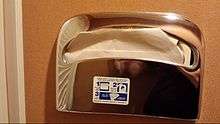
- Toilet with toilet seat; whereas a home toilet seat has a lid, a public toilet may or may not
- Toilet paper, often within a lockable dispenser
- Coat hook
- "Pull-down" purse holder
- Sanpro bin for menstrual products; this may be classified as clinical waste and be subject to special regulations concerning disposal
- Dispenser for flushable paper toilet seat covers
At the point of handwashing
- Faucets (taps), note some are at a lower level for children and wheelchair users
- Antiseptic handwash dispenser or soap dispensers, pump bottles or auto dispensers (not commonly supplied)
- Mirror (usually over sinks)
- Waste container / rubbish bin
Elsewhere
- Urinals (almost exclusively in public toilets for males; although see female urinal)
- Vending machines dispensing condoms, diapers (nappies), painkillers, energy drinks, perfume, breath mints, facial tissue, confectionery, undergarments, swimwear, soap, sex toys, or sanitary napkins or tampons
- Air fresheners or odour control systems
- Infant changing table, often fold-down (usually in women's rooms, but increasingly also in men/s rooms)[19]
- Sometimes showers are also present, often with soap, shampoo, or similar dispensers (often at truck stops)
Cleaning, maintenance and management
Thorough cleaning and maintenance are important for public toilets. This task is usually performed by a "public toilet attendant" (who is there during an entire shift) or by professional cleaning staff. They maintain and clean the facilities, ensuring that toilet paper, soap, paper towels, and other necessary items are kept stocked.
Public toilets need both periodic maintenance and emergency cleaning.[20] Volunteer-managed facilities may also be an option in some cases.[20]
Costs and economics
User fees
Toilets that require the user to pay may be street furniture or be inside a building, e.g. a shopping mall, department store, or railway station. The reason for charging money is usually for the maintenance of the equipment. Paying to use a toilet can be traced back almost 2000 years, to the first century AD. The payment may be taken by a bathroom attendant, or by a coin-operated turnstile or cubicle door (see John Nevil Maskelyne, who invented a doorlock requiring the insertion of a penny coin, hence the euphemism to "spend a penny".[21]) The first pay toilet in the United States was installed in 1910 in Terre Haute, Indiana.[22]
Privatization and closures
In some places, the provision of public toilet facilities is under great pressure.[23][24] One response by public authorities is to close the buildings, often citing criminal activity.[25][26] The United Kingdom government austerity programme has led to major council cut-backs to public toilet provision, with knock-on effects on the public realm as a whole.[27] Some of the buildings, particularly the underground ones, are sold and used for other purposes, e.g. as a bar.
Another response is to privatise the toilets, so that a public good is provided by a contractor,[28] just as private prisons are. The toilets may fall under the category of privately owned public space - anyone can use them, but the land ultimately belongs to the corporation in question. When toilets that have been privatised are improperly run, or closed, there may be calls to take them back into the control of the public authority, as with Westminster Council in central London - one of the wealthiest places in the world, where members of the public are reduced to urinating in the parks and streets for lack of available facilities.[29]
Toilets in particular locations
Shopping centres
Customers often expect retail stores and shopping centres to offer public toilets. Customers rank complimentary toilets highly, and their availability influences shopping behaviour. By offering appropriate customer toilets, retail stores and shopping centres may enhance their profits and image; however, many retailers pay insufficient attention to their customer toilet facilities. Due to the potential of customer toilets to increase profits and improve store image, retailers could benefit from regarding toilets as a marketing investment rather than a property expense.[30] Some business, like Starbucks, have officially opted to let anyone use their toilets, without having to purchase anything.[31][32]
Schools
.jpg)
Lack of adequate school toilets is a very serious problem in many developing countries, and contributes to many problems from poor child health to school drop out. Many pit latrines are not adequately built for young children, which has resulted in the tragic consequence of children dying by falling inside the hole.[33] Globally, about 620 million children do not have adequate toilets at school and around 900 million cannot wash their hands properly; and almost half of the schools do not provide soap.[34]
The situation of inadequate school toilets violates the children's right to education and to right to water and sanitation.[35] Such situations are common in many parts of the world, especially in Africa and South Asia, but also in other regions. For example, in the Caucasus and Central Asia, 30% of schools do not provide adequate toilets and 37% of schools do not have access to adequate water supplies.[35] The presence of soap and toilet paper is very important, but is largely non-existent in many regions.[35] Missing or inadequate doors and partitioning are observed in both high- and low-income countries, which can affect the children's self-esteem, especially around puberty; in the case of girls, lack of menstrual hygiene management and privacy (such as the availability of functional toilet doors with locks, disposal facilities and menstrual hygiene products in schools, lack of soap and toilet paper) can severely impact upon their well-being and is considered a form of violation of girl's rights.[35]
The Bill & Melinda Gates Foundation has funded several research projects for provision of community, shared or school toilets in developing countries since 2011 when they launched their "Reinvent the Toilet Challenge".[36][37]
Prisons
It is today accepted in the countries of the Council of Europe that a lack of basic privacy is a violation of fundamental rights. For example, the European Court of Human Rights ruled in Szafrański v. Poland (2015) that the forcing of prisoners to use the toilet without adequate privacy amounts to a violation of Article 8 (right to respect for private life) of the European Convention on Human Rights.[38]
Society and culture
Unisex (gender neutral)
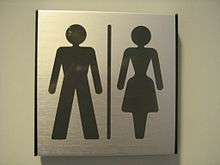
Public toilets are usually separated by sex, except for those to be used by people with disabilities. In many cultures, this separation is so characteristic that pictograms of a man or a woman often suffice to indicate the facility, without explicit reference to the fixtures themselves. In restaurants and other private locations, the identifications can be designed to match the decoration of the premises.[39] Some toilets also function, in part, as changing rooms (locker rooms), owing to their sex-separated nature. For example, in beach areas, a portion of the building is equipped with benches so that people can change into or out of their bathing suits.
Amnesty International includes sex-separated toilets among its list of suggested measures to ensure the safety of women and girls in schools.[40] In jurisdictions using the Uniform Plumbing Code in the U.S., sex separation is a legal mandate via the building code.[41] In many places the queues for the women's toilets are longer than those for the men's; efforts to deal with this are known as potty parity.
In the 21st century, with lobbying from the transgender rights movement, some initiatives have called for gender-neutral public toilets, also called unisex public toilets (also called gender-inclusive, gender-neutral or all-gender).[42]
Many public toilets have either individual or gender-neutral facilities. They can accommodate people with disabilities, elderly persons who may require assistance from a carer of another gender, or other cases where public sex-separated facilities might lead to discomfort.[43] Gender-neutral toilets are also an option in cases where sex-separated ones are not practical, such as in aircraft lavatories and passenger train toilets. Toilet facilities for disabled people, especially those reliant on a wheelchair, may be either unisex or gender-specific.[44]
Graffiti and street art
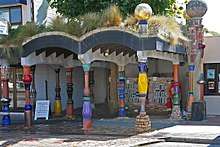
Public toilets have long been associated with graffiti, often of a transgressive, gossipy, or low-brow humorous nature (cf. toilet humour). The word latrinalia—from latrine (toilet) and -alia (a collection)—was coined to describe this kind of graffiti.[45] A famous example of such artwork was featured on the album cover of the satirical Tony Award Broadway musical Urinetown, using felt-tip pen scribblings.
As graffiti merged into street art, so some public street-level toilets began to make a feature of their visibility. The Hundertwasser toilet block is a colourful example in Kawakawa, New Zealand, designed by an Austrian artist and viewed as a tourist draw in a small town.
Drugs, vandalism and violent crime
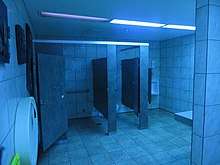
Some public toilets are known for drug-taking and drug-selling, as well as vandalism. This type of criminal activity is associated with all "neglected, unsupervised buildings", not just toilets, and good cleanliness and maintenance, and ideally an attendant on the premises, can act as a protection against these problems.[46]
Violent crime inside public toilets can be a problem in areas where the rate of such crimes in general is very high. In South Africa, for instance, many people have reported being afraid to use public toilets.[47] There have been several highly publicized murders in public toilets, such as the Seocho-dong public toilet murder case in South Korea in 2016. In the US, an infamous case was the murder of a 9-year-old boy in 1998 in a San Diego county public toilet.[48]
Anonymous sex
Before the gay liberation movement, public toilets were amongst the few places where men too young to enter gay bars legally could meet others who they knew with certainty to be gay.[49] Many, if not most, gay and bisexual men at the time were closeted, and almost no public gay social groups were available for those under legal drinking age.[50] The privacy and anonymity public toilets provided made them a convenient and attractive location to engage in sexual acts then.
Sexual acts in public toilets are outlawed in many jurisdictions (e.g. the Sexual Offences Act 2003 in the UK).[51][52][53] It is likely that the element of risk involved in cottaging makes it an attractive activity to some.[54][55]
Symbols in unicode
Unicode provides several symbols for public toilets.[56]
| Symbol | Code | Name | Value | Image |
|---|---|---|---|---|
| 🚹 | U+1F6B9 | MENS SYMBOL | men's toilet | |
| 🚺 | U+1F6BA | WOMENS SYMBOL | women's toilet | |
| 🚻 | U+1F6BB | RESTROOM | public toilet or unisex public toilet | |
| 🚼 | U+1F6BC | BABY SYMBOL | baby changing station | |
| ♿ | U+267F | WHEELCHAIR SYMBOL | disabled accessible facilities | |
| 🚽 | U+1F6BD | TOILET | public toilet | |
| Source:[56][57] | ||||
Legislation
Countries have legislation stipulating how many public toilets are required in a given area for customers or for employees.
Employees' rights to use the toilet while at work vary between jurisdictions.
United States
The Restroom Access Act is legislation several U.S. States passed that requires retail establishments with toilet facilities for employees to also allow customers to use the facilities if the customer suffers from an inflammatory bowel disease or other medical condition requiring immediate access to a toilet.
United Kingdom
In the United Kingdom, the Workplace (Health, Safety and Welfare) Regulations 1992 requires businesses to provide toilets for their employees,[58] along with washing facilities including soap or other suitable means of cleaning. The Workplace (Health, Safety and Welfare) Approved Code of Practice and Guidance L24, available from Health and Safety Executive Books, outlines guidance on the number of toilets to provide and the type of washing facilities associated with them.[59]
Local authorities are not legally required to provide public toilets, and while in 2008 the House of Commons Communities and Local Government Committee called for a duty on local authorities to develop a public toilet strategy,[60] the Government rejected the proposal.[61]
History


Europe
Public toilets were part of the sanitation system of ancient Rome, often in proximity to or as part of public baths (thermae).[62] By the Middle Ages public toilets became uncommon, with only few attested in Frankfurt in 1348, in London in 1383, and in Basel in 1455.[63] A public toilet was built in Ottoman Sarajevo in 1530 just outside a mosque’s exterior courtyard wall which is still operating today.[64]
In the early 19th century, large cities in Europe started installing public toilets: first in Paris, then in Berlin in 1820 and in London in 1851.[63]
George Jennings, the sanitary engineer, introduced public toilets, which he called "monkey closets", to the Crystal Palace for The Great Exhibition of 1851.[65] Public toilets were also known as "retiring rooms"[66] (cf "drawing room", from "to withdraw", and waiting room.)
Underground public toilets were introduced in the United Kingdom in the Victorian era, in built-up urban areas where no space was available to provide them above ground. The facilities were accessible by stairs, and lit by glass brick on the pavement. Local health boards often built underground public toilets to a high standard, although provisions were higher for men than women. Most have been closed as they did not have disabled access, and were more prone to vandalism and sexual encounters, especially in the absence of an attendant. A few remain in London, but others have been converted into alternative uses such as cafes, bars and even dwellings.
Hong Kong
In the early days of the colony of Hong Kong, people would go to the toilet in sewers, barrels or in alleys. Once Hong Kong opened up for trade (1856-1880), the British Hong Kong government determined that the appalling hygiene situation in Hong Kong was becoming critical. Thus, the government set up public toilets (squat toilets) for people in 1867. But these toilets needed to cleaned and emptied manually every day and were not popular.[67][68] In 1894, plague broke out in Hong Kong and 2,500 people died, especially public toilet cleaners. The government decided to act, setting up underground toilet facilities to improve this situation, though these toilets also had to be cleaned and emptied manually.[68][67]
Early in 1940, the colonial government built the first public flush toilet. In 1953, a fire broke out in Shek Kip Mei. After that, the government embarked on a major public housing project in Hong Kong including public toilets for residents. More than ten people shared each toilet and they used them for bathing, doing their laundry as well as going to the toilet.[69] Finally, in the 1970s, the government decided that one toilet for four or five families was insufficient and renovated all public housing providing separate flush pedestal toilets for all residents.[70]
United States
In the United States, concerns over public health and sanitation spurred the sanitarian movement during the late 1800s.[71] Reforms to standardize plumbing codes and household plumbing were advocated for; the intersection of advancements in technology and desire for cleanliness and disease-free spaces spurred the development of public toilets.
Facilities for women sometimes had a wider emphasis, providing a safe and comfortable private space in the public sphere. The Ladies Rest Room is one example of the non-euphemistic use of the term: literally, a place to rest. Historically such rooms pre-dated the washroom and washrooms were added afterwards. Subsequent integrated designs resulted in the "women's restroom lounge".[72]
A notable early example of a public toilet in the United States is the Old School Privy. The American architect Frank Lloyd Wright claimed to have "invented the hung wall for the w.c. (easier to clean under)" when he designed the Larkin Administration Building in Buffalo, New York in 1904.
Social hierarchies (access for women)
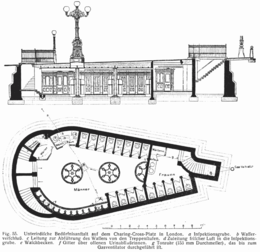
The presence or absence of public toilets has also long been a reflection of a society's class inequalities and social hierarchies.[73]
The lack of public toilets for women reflects the exclusion of females from the public sphere. Prior to the twentieth century, after leaving their parent's home, women were expected to maintain a career as homemaker and wife. Thus, safe and private public toilets were rarely available for women. The result was that they were often restricted in how far they could travel away from home without returning. Alternatively, they had to make do in the public streets as best they could. They often experienced sexual harassment as men tried to "sneak a peak" or otherwise bothered them.[74]:253–54, 290 Some women experienced even worse if they could not secure safety and privacy even at home or in their workplaces. There problems continue for women in all parts of the world.
The practice of pay toilets emerged in the US in the late 19th century. In these spaces, public toilets could only be accessed by paying a fee. Sex-separated pay toilets were available at the Chicago World's Fair (US) in 1893.[74]:253 Women complained that these were practically unavailable to them, authorities allowed them to be free, but on Fridays only.[74]:253 In the twentieth century, activist groups in the U.S., including the Committee to End Pay Toilets in America claimed that such practices disadvantaged women/girls because men/boys did not have to pay for urinals.[75] As an act of protest against this phenomenon, in 1969 California Assemblywoman March Fong Eu destroyed a toilet on the steps of the California State Capitol.[76] Although by the 1990s most US jurisdictions had migrated away from pay toilets, until 1992, U.S. female senators had to use toilets located on different floor levels than the ones they were working on, a reflection of their intrusion in an all-male profession.[77]
While some public facilities were available to women in London by 1890, there were much fewer than those available to men.[78]:69
Toilets also were assigned strong moral overtones. While public water closets were considered necessary for sanitation reasons, they were viewed as offending public sensibilities. It has been said that because public facilities were associated with access to public spaces, extending these rights to women was viewed as "immoral" and an "abomination".[79] As a result of Victorian era codes, women were delegated to the private sphere, away from the public, fulfilling their roles as dutiful wives and mothers where any association with sexuality or private body parts was taboo. For women, the female lavatory in a public space was associated with danger and immoral sexual conduct.[80]
Racial segregation
After slavery ended in the U.S., southern states began to attempt to replicate its social economic oppression by passing laws requiring that blacks and whites be separated in all public and private venues. In parts of the United States, public toilets were subject to racial segregation, due to the Jim Crow laws prior to the Civil Rights Act of 1964. This segregation imposed significant restrictions on the lives of African-Americans.[81] Strategies to keep African Americans out of sight included the "basement solution": by locating public toilets for black people in the basement next to janitor supply rooms, Jim Crow laws were able to maintain separation of the races.[82] Black workers often had to walk long distances to get to the toilets they were assigned.[83]
Those who were able to afford cars could avoid the indignities of segregated trains and buses, but they faced the difficulty of finding a public toilet they were allowed to use. Courtland Milloy of the Washington Post recalled that on cross-country roadtrips in the 1950s his parents were reluctant to stop the car to allow the children to relieve themselves – it just wasn't safe.[84] One solution to this was to carry a portable toilet (a sort of bucket-like arrangement) in the trunk of the car.[85] This treatment led to the creation of The Negro Motorist Green Book, an annually updated guidebook.[86] Once the traveler found the correct "colored restroom", it could serve "as a respite from the insults of the white world", akin to what is now called safe space.[87]
South Africa
During the apartheid years in South Africa, public toilets were usually segregated by race.[88]
Gallery

 Typical male public toilet in the United States
Typical male public toilet in the United States.jpg) Public toilet at the Vienna State Opera has recorded music
Public toilet at the Vienna State Opera has recorded music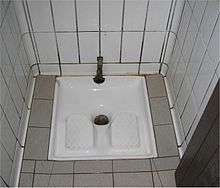 Roadside squat toilet near Toulouse, France
Roadside squat toilet near Toulouse, France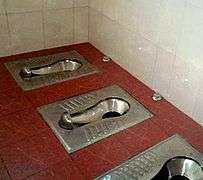 Squat toilets in Beijing, China
Squat toilets in Beijing, China Trough closet cubicles in a Hong Kong factory
Trough closet cubicles in a Hong Kong factory Public toilet in New Hampshire
Public toilet in New Hampshire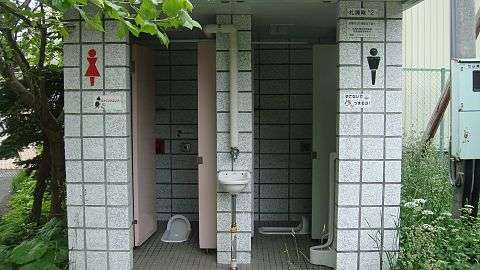 Public toilet at Jozankei Hot Springs, Hokkaido, Japan
Public toilet at Jozankei Hot Springs, Hokkaido, Japan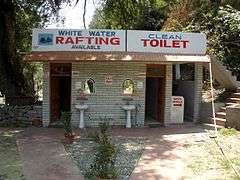 Public toilets near Kullu, India
Public toilets near Kullu, India Public toilets near cinema in Bangalore, India
Public toilets near cinema in Bangalore, India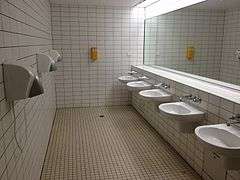 Sinks in the public toilet of the Queensland Art Gallery
Sinks in the public toilet of the Queensland Art Gallery.jpg) Inside of cubicle in public toilet in informal settlement in Kampala, Uganda
Inside of cubicle in public toilet in informal settlement in Kampala, Uganda Instructions posted in women's, German public toilet
Instructions posted in women's, German public toilet Gents' toilets in Harrods department store in London
Gents' toilets in Harrods department store in London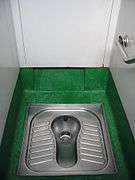 Public squat toilet in Hong Kong
Public squat toilet in Hong Kong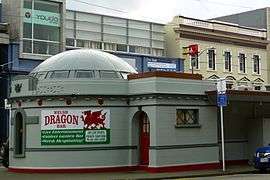 Welsh Dragon Bar, Wellington, New Zealand; formerly a public toilet
Welsh Dragon Bar, Wellington, New Zealand; formerly a public toilet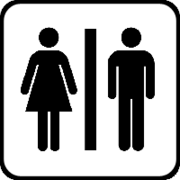 Toilet sign / AIGA badges
Toilet sign / AIGA badges
See also
| Wikimedia Commons has media related to Public toilets. |
- National Public Toilet Map (in Australia)
- Sanitation
- Spray-and-vac cleaning, a method of professional cleaning
References
- https://www.therecord.com/living-story/9553018-flash-from-the-past-hollywood-glamour-appears-in-kitchener-when-the-capitol-opens/
- "Away from home toilet charter" (PDF). British Toilet Association. Retrieved 21 March 2017.
- "Archived copy". Archived from the original on 2017-04-06. Retrieved 2017-04-06.CS1 maint: archived copy as title (link)
- BRYAN HILL (12 July 2015). "Money Does Not Stink: The Urine Tax of Ancient Rome". Ancient Origins. Retrieved 15 May 2018.
Vespasian's name is still attached to public urinals in France (vespasiennes), Italy (vespasiani), and Romania (vespasiene)
- Mulrooney, Thomas. "Public Toilets Around the World". Plumbworld News. Archived from the original on 1 November 2013. Retrieved 20 January 2014.
- "Clean sweep: How digital solutions like e-toilets are taking on open-defecation". https://www.hindustantimes.com/. 24 March 2018. Retrieved 6 April 2018. External link in
|work=(help) - "Urilift pop-up urinals". Urilift. Retrieved 21 March 2017.
- "What are Changing Places Toilets?". Changing Places. Retrieved 21 March 2017.
- Molotch, Harvey; Noren, Laura, eds. (2010). Toilet: Public Restrooms and the Politics of Sharing. New York: NYU Press.
- Penner, Barbara (2013). Bathroom. Reaktion Books.
- "Give us a (Loo) break!" (8 March 2010) Trade Union Congress <https://www.tuc.org.uk>
- "Occupational Safety and Health Administration, Standard Number: 1910.141(c)(1)(i)". United States Department of Labor. Retrieved 28 April 2017.
- US Public Health Mandates and the Restroom Problem in America, American Restroom Association, World Toilet Summit, Delhi, November 1, 2007
- "About the National Toilet Map". The National Toilet Map. Australian Government: Department of Health and Ageing. 2006. Retrieved 2006-04-14.
- McCreary, C. (2020) Public Restrooms and COVID-19: Guidelines for Reopening, PHLUSH, Portland, Oregon, USA
- Huang, Cunrui; Ma, Wenjun; Stack, Susan (1 August 2012). "The Hygienic Efficacy of Different Hand-Drying Methods: A Review of the Evidence". Mayo Clinic Proceedings. 87 (8): 791–798. doi:10.1016/j.mayocp.2012.02.019. PMC 3538484. PMID 22656243.
- WHO (2018). Guidelines on Sanitation and Health. Geneva: World Health Organization, ISBN 978-92-4-151470-5
- "Show Me the Science – How to Wash Your Hands". www.cdc.gov. 2020-03-04. Retrieved 2020-03-06.
- "Should men's restrooms have diaper changing tables? New bill says yes". Retrieved 6 July 2014.
- PHLUSH (2015) Public Toilet Advocacy Toolkit, Part 1: Strategy Tools, Section 4: Plan for Operational and Financial Sustainability, also available in SuSanA library
- Lamont, Peter (2004). The Rise of the Indian Rope Trick, (The Biography of a Legend) (1 ed.). Time Warner Books. ISBN 0-316-72430-0.
- Gruenstein, Peter (4 Sept 1975) Pay toilet movement attacks capitalism, The Beaver County Times, Retrieved October 19, 2010 (with sarcastic subtitle for 1975, "How about charging air for tires?")
- [Public toilets 'wiped out in parts of UK']
- "Council could close 'cottaging' toilets in Lincoln city centre". BBC. 2 August 2014. Retrieved 20 December 2016.
- "Public toilets face closure amid sordid sex sessions". Loughborough Echo. 4 March 2009. Retrieved 20 December 2016.
- Dunnico, David (1 June 2014). "Inconvenienced: how the cuts have hit public toilets". Red Pepper. Retrieved 3 May 2019.
- "Let's privatise the loos. Yes, seriously". Institute of Economic Affairs. 31 May 2016.
- pdimoldenberg (19 March 2013). "Call to take back privatised Westminster public toilets closed by Lord Ashcroft's company".
- Piha, Samuel; Räikkönen, Juulia (May 2017). "When nature calls: The role of customer toilets in retail stores". Journal of Retailing and Consumer Services. 36: 33–38. doi:10.1016/j.jretconser.2017.01.005.
- Harriet Agerholm (11 May 2018). "Starbucks chairman says coffee shop 'toilets are open to everyone'". The Independent. Retrieved 16 May 2018.
- Zlati Meyer (11 May 2018). "Starbucks changes bathroom policy after Philadelphia arrest: Anyone may use them". USA Today. Retrieved 16 May 2018.
- Fihlani, Pumza (2018-06-04). "Why children are drowning in toilets". BBC News. Retrieved 2018-11-19.
- Gulland, Anne (2018-08-27). "Lack of toilets and water at school puts girls' education at risk". The Telegraph. ISSN 0307-1235. Retrieved 2018-11-19.
- http://www.euro.who.int/__data/assets/pdf_file/0007/321838/Prioritizing-pupils-education-health-well-being-en.pdf?ua=1
- BMGF (2015). Building demand for sanitation - a 2015 portfolio update and overview - Water, sanitation, and hygiene strategy, June 2015. Bill & Melinda Gates Foundation, Seattle, Washington, USA
- BMGF (2018). MEDS Convening 2018 - Conversations about Sanitation, SDGs and Research. Bill & Melinda Gates Foundation, Seattle, USA
- https://hudoc.echr.coe.int/eng#{%22appno%22:[%2217249/12%22],%22itemid%22:[%22001-159205%22]}
- Michael, Jane; Michael Stern (1999-09-13). "Operators shouldn't get potty over bathroom symbols". Nation's Restaurant News. Archived from the original on 2008-06-17. Retrieved 2009-02-27.
- "Six steps to stop violence against schoolgirls, Document ACT 77/008/2007". Amnesty International. November 2007. Retrieved 2009-02-27.
- "2009 UNIFORM PLUMBING CODE, 412.3" (PDF). Uniform Plumbing Code. Ontario, California: International Association of Plumbing and Mechanical Officials: 34. 2009. ISSN 0733-2335. Archived from the original (PDF) on 2014-08-11. Retrieved 2014-04-11.
- La Ganga, Maria L (30 March 2016). "From Jim Crow to transgender ban: the bathroom as battleground for civil rights". The Guardian. Retrieved 24 October 2016.
- Devine, Shannon (2004-03-11). "Inclusive toilets". McGill Reporter. Retrieved 2009-02-27.
- Toilet Signs at Adept Safety Online (informative commercial site)
- Palazzolo, Rose. "Latrinalia - Learning From the Scrawls in the Bathroom". ABC News. Retrieved 30 October 2013.
- Greed, Clara (2007). Inclusive Urban Design: Public Toilets. Routledge. p. 255.
- "'It's not safe': South Africans fear using public toilets after woman murdered - CBC Radio". CBC. November 15, 2016.
- "CNN - Suspect arrested in case of boy killed in public bathroom - November 16, 1998". edition.cnn.com.
- Prejudice and Pride: Discrimination Against Gay People in Modern Britain by Bruce Galloway; Published by Routledge, 1983; ISBN 0-7100-9916-9, ISBN 978-0-7100-9916-7.
- David Northmore (11 April 1998). "Finding private passion in a public place; Why is it that some gay men go in search of sexual encounters in lavatories?". The Independent.
- Galop.org.uk Archived 2013-10-05 at the Wayback Machine, Cottaging and cruising: your safety, your rights and the law.
- Kingston Hospital NHS Trust, Sex and the law.
- Sexual Offences Act 2003, part 1, paragraph 71,
- Public Sex/gay Space by William Leap; Published by Columbia University Press, 1999; ISBN 0-231-10691-2, ISBN 978-0-231-10691-7.
- Kirchick, James (1 November 2009). "Cruise Control". The Advocate. Archived from the original on 10 October 2009. Retrieved 22 October 2009.
- Unicode.org, Transport and Map Symbols. Range: 1F680–1F6FF. (accessed 6 November 2012)
- Unicode.org, Miscellaneous Symbols. Range: 2600–26FF. (accessed 6 November 2012)
- "The Workplace (Health, Safety and Welfare) Regulations 1992". www.legislation.gov.uk.
- "Health and Safety Executive Books". Archived from the original on 2015-05-12. Retrieved 2018-12-01.
- "The Provision Of Public Toilets" (PDF). House of Commons. Retrieved 20 January 2014.
- "Government Response to Public Toilet Provision" (PDF). www.gov.uk. Retrieved 20 January 2014.
- Heikki S. Vuorinen (2010): "Water, toilets and public health in the Roman era", in Water Science & Technology: Water Supply, pg.211
- Peter Kasza:"Das große Latrinum: 155 Jahre öffentliche Toilette", in Der Spiegel, 22 June 2007
- "Visit the oldest public toilet in Bosnia - Touring Bird". www.touringbird.com. Retrieved 2019-09-09.
- Hibbert, Christopher (2008). The London Encyclopaedia. p. 668.
- Oxford Dictionary https://en.oxforddictionaries.com/definition/retiring_room. Retrieved 24 October 2016. Missing or empty
|title=(help) - "Apple Daily toilet" (in Chinese). Retrieved 6 March 2018.
- "Hong Kong toilet revolution" (in Chinese). Retrieved 17 December 2018.
- "Apple Daily Shek Kip Mei was fire". Retrieved 26 December 2013.
- "Hong Kong Housing Authority". Retrieved 2009. Check date values in:
|access-date=(help) - Kogan, Terry S. "Sex-Separation in Public Restrooms: Law, Architecture, and Gender." Michigan Journal of Gender & Law; Ann Arbor 14.1 (2007): 1–57. Print.
- Yuko, Elizabeth (3 December 2018). "The Glamorous, Sexist History of the Women's Restroom Lounge". Citylab. Retrieved 3 December 2018.
- Gershenson, Olga (2010). "The Restroom Revolution: Unisex toilets and campus politics" (PDF). In Molotch, Harvey; Norén, Laura (eds.). Toilet: Public Restrooms and the Politics of Sharing. New York City: New York University Press. ISBN 978-0-8147-6120-5.
- Carter, W. Burlette (2018). "Sexism in the 'Bathroom Debates': How Bathrooms Really Became Separated By Sex". Yale Law & Policy Review. 37 (1): 227–297. SSRN 3311184.
- Gordon, Aaron (June 14, 2017). "Why Don't We Have Pay Toilets in America". Pacific Standard Magazine.
- "Social inclusion, toilet rights, and legal protection for transgender Americans". Retrieved March 4, 2017.
- Plaskow, Judith (July 8, 2008). "Embodiment, Elimination, and the Role of Toilets in Struggles for Social Justice". Cross Currents. 58 (1): 51–64. doi:10.1111/j.1939-3881.2008.00004.x.
- Penner, Barbara. Bathroom. Reaktion Books, 2013.
- Greed, Clara. Inclusive Urban Design: Public Toilets. Routledge, 2007.
- Nirta, Caterina (August 3, 2014). "Trans Subjectivity and the Spatial Monolingualism of Public Toilets". Law and Critique. 25 (3): 271–288. doi:10.1007/s10978-014-9141-9. ISSN 0957-8536.
- Published in The Public Historian, ed. Randolph Bergstrom, Volume 27, Issue 4, Fall 2005, pages 11-44. Weyeneth, R. R. (2005). The architecture of racial segregation: The challenges of preserving the problematic past. The Public Historian, 27(4), 11-44. DOI: 10.1525/tph.2005.27.4.11
- Weyeneth, Robert R. (2005). "The Architecture of Racial Segregation: The Challenges of Preserving the Problematical Past". The Public Historian. 27 (4): 11–44. doi:10.1525/tph.2005.27.4.11.
- Yellin, Eric S. Racism in the Nation's Service: Government Workers and the Color Line in Woodrow Wilson's America. University of North Carolina. pp. 117, 119. ISBN 9781469608020.
- Milloy, Courtland (June 21, 1987). "Black Highways: Thirty Years Ago We Didn't Dare Stop". The Washington Post. Retrieved October 24, 2016.
- Sugrue, Thomas J. "Driving While Black: The Car and Race Relations in Modern America". Automobile in American Life and Society. University of Michigan. Retrieved October 24, 2016.
- Wright, Gavin (2013). Sharing the Prize. Harvard University Press. pp. 75–76. ISBN 9780674076440.
- Molotch, ed. by Harvey; Norén, Laura (2010). Toilet. ; Public Restrooms and the Politics of Sharing. New York: New York University Press. ISBN 978-0814795897.CS1 maint: extra text: authors list (link)
- "S. Africa Abolishes 1953 Law Segregating Public Amenities". Los Angeles Times. 15 October 1990. Archived from the original on 16 October 2012. Retrieved 29 August 2009.
External links
- British Toilet Association Campaigning for Better Public Toilets for All
- American Restroom Association America's advocate for the availability of clean, safe, well designed public restrooms
- Australia's National Public Toilet Map shows the location of more than 14,000 public and private public toilet facilities across Australia.
- Public Toilets Database Locations of public toilets in 18 countries. New locations and comments can be added. Detailed information includes the geographic coordinates and quality of the facility.
- Needaloo The Uk Online Disabled Loo Locator
- PHLUSH Volunteer advocacy group for public toilets
